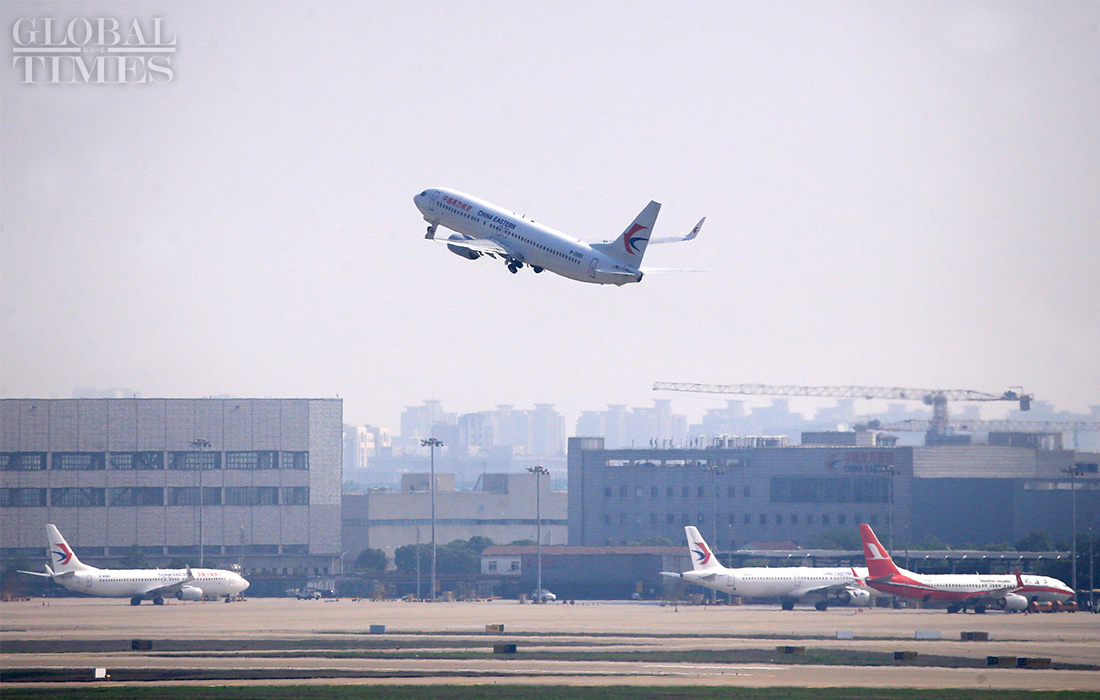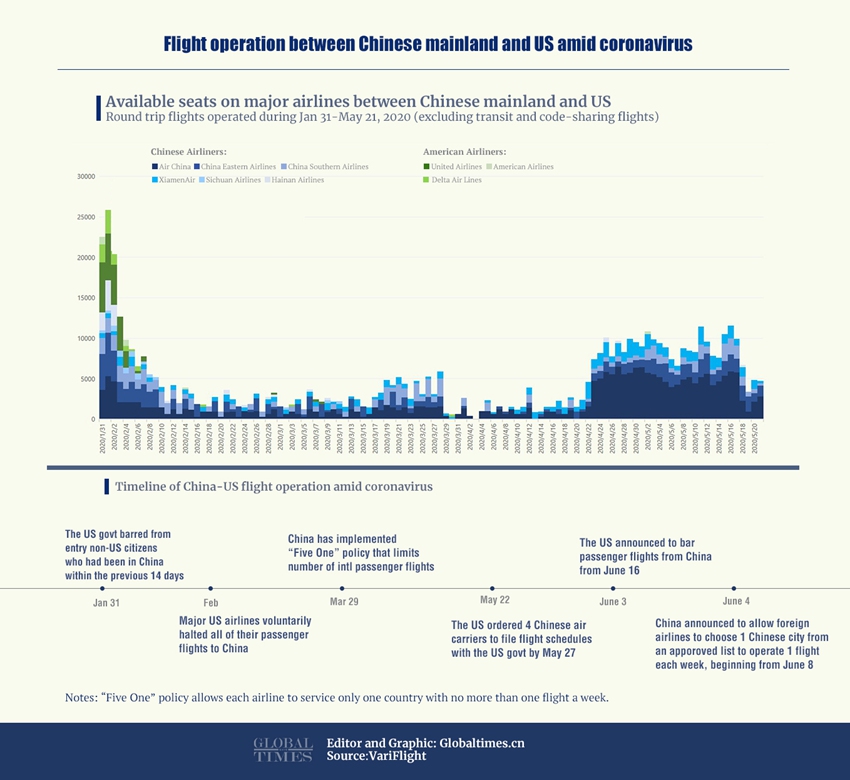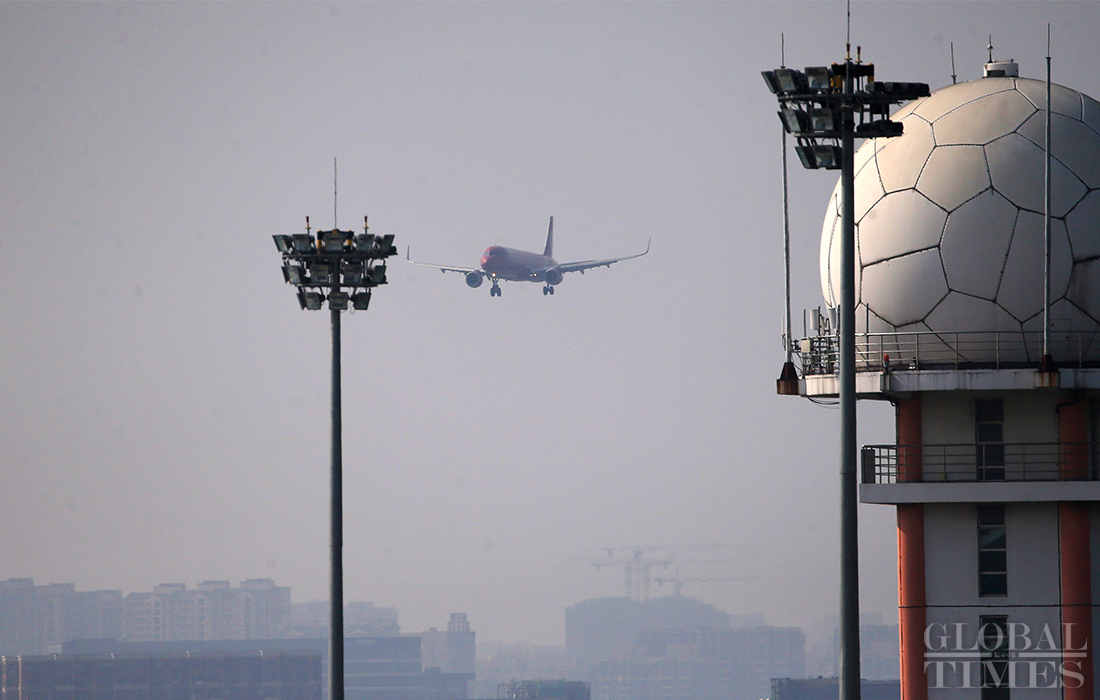China to cautiously ease international flight restrictions but not due to US bullying tactics
By GT staff reporters Source:Global Times Published: 2020/6/4 21:33:41
Adjustments not response to US bullying; bilateral negotiations to continue: analyst

Photo: Yang Hui/GT
China on Thursday took a cautious yet significant step to loosen restrictions on international flights put in place to stem the spread of the novel coronavirus. This move aims to pave the way for more global carriers to resume services to dozens of Chinese cities to meet rising demand for global travel while maintain necessary anti-epidemic measures to prevent a much-feared influx of imported cases.
The move will potentially allow all qualified international airlines to resume operations to over 30 Chinese cities, marking the most significant opening measure in over two months, though the airlines will have to meet specific, strict viral prevention procedures and requirements under a circuit-breaker and reward mechanism that, industry analysts say, leaves sufficient flexibility to balance between boosting travel and preventing a viral resurgence.
Though the new rules came one day after a US plan to ban all flights from China, the Chinese regulations weren't drafted overnight and not rushed in response to US bullying tactics, analysts said. Potential tension over the issue will likely persist between the two countries as the US resorted to its bullying tactics while China often sticks to its own plan, as is the case in the entire dynamic, analysts added.
Innovative opening
Under the rules released by the Civil Aviation Administration of China (CAAC) on Thursday morning, all international carriers that were not previously allowed to resume operations can choose one out of 37 designated Chinese cities to resume one flight each week starting on Monday. That means, in theory, US airlines, including United and Delta, can now also apply for flight resumption.
In a separate statement released on Thursday afternoon, the CAAC also said that China could increase flights to and from "qualified" countries that meet criteria such as the country in question has "exported" relatively less COVID-19 cases and has close economic ties with China; there is real demand for Chinese nationals to return home; the country has "far-ending" viral prevention capabilities that can reduce risks and that the country has established "green channels" with China.
Some analysts noted that the statement left more room for easing flight restrictions for countries such as Japan, South Korea, Singapore and the US, which all meet most of the requirements, although the COVID-19 epidemic still remains dire in the US and Japan. South Korea and Singapore have already established "green channels" with China.
The CAAC said that the move could include 95 foreign airlines that have not suspended flights to China. Starting on Monday, as much as 64 new international flights could be added, bringing total international arrivals to about 33,000 a week, according to the CAAC statement.
The adjustments are the most significant move since China adopted what's known as a "Five One" policy on international flights in mid-March, under which each airline is permitted to only serve one country, from one Chinese city to a foreign one, with no more than one flight a week. The strict measures were put in place to stop the influx of imported COVID-19 cases, at a time when the virus continued to spread around the world.
"[The new regulations] were a very positive signal that China is gradually and safely resuming international flights based on its domestic needs, as the global pandemic is abating and internal prevention and control measures are improved," Zheng Hongfeng, CEO of industry information provider VariFlight, told the Global Times on Thursday.
As the economic recovery both inside China and across the world is picking up pace, the demand for international flights in and out of China is also skyrocketing. The US government's move to ban flights in order to pressure China to allow more flights by US airlines, despite its twisted logic, is also a direct reflection of that surging demand, analysts noted.
Apart from business travel, there are also many Chinese citizens overseas who are fighting for limited and expensive air tickets to return home. In the Thursday afternoon statement, the CAAC made it clear that the move was also aimed at meeting the "urgent need" of Chinese students and others to return.
More than just meeting the rising demand, the new rules also offer a specific and feasible action plan for resuming international travel, Qi Qi, an independent market analyst, told the Global Times on Thursday.
One of the highlights of the new rules is what the CAAC called a circuit-breaker and reward mechanism that could determine the fate of the future operations of each airline based on the number of potential COVID-19 cases. For instance, if all passengers on one airline test negative for three weeks straight, the airline will be permitted to add one more flight; if five passengers on a flight test positive, the responsible airline would have to halt operations for a week; if 10 tested positive, then four weeks. All passengers would have to undergo a nucleic acid test upon arrival.
The new mechanism has been hailed as an innovative and targeted step that fits into a delicate balance between the normalization of anti-epidemic efforts and economic recovery.
"The new policies focus on international flights that do not endanger [China's] borders," Qi said.
The mechanism could be challenging for some airlines, particularly those operating in relatively high-risk areas. A source with one of the international airlines told the Global Times that preventing cases is a task for all parties involved rather than the airline itself.
There have been some reports of COVID-19 cases on several international flights. On May 30, 11 passengers on an Egypt Air flight from Cairo to Chengdu, capital of Southwest China's Sichuan Province, tested positive for COVID-19. There have also been reports about some flights from Russia carrying five or more COVID-19 cases.

Infographic: GT
Not for US bullying
Just like in most other cases, China's new rules on international flights have also been seen largely in the prism of tensions between Beijing and Washington, especially as the CAAC announcement came just hours after the US announced Wednesday night a ban on all passenger flights to the US conducted by Chinese carriers, as punishment for Chinese officials' decision not to allow US carriers to resume operations.
Chinese sources and analysts said on Thursday that the new regulations were likely based on thorough studies of the domestic situation and unlikely a response to what they call bullying tactics from the US, let alone a compromise, as some foreign media outlets have painted.
"The CAAC's policy adjustments neither came overnight nor were a rushed decision. It is a response to rebound demand in global civil aviation market and based on considerations for all after constant engagement with all parties," Wang Ya'nan, chief editor of Aerospace Knowledge magazine, told the Global Times on Thursday
In announcing the flight ban, the US Department of Transportation asserted that China did not permit US carriers to exercise their "bilateral rights" to conduct air services to and from China. It said the ban on all Chinese flights was to take effect on June 16.
The move fits into the US administration's approach to all issues - always imposing sanctions first, which not only are counterproductive to addressing the issue but also will hurt itself, analysts noted.
"Washington has shut the door for negotiations of air routes between China and the US. And Trump did not give US companies that need air services with China any benefit," an industry insider surnamed Li told the Global Times, noting that the US has so far the worst epidemic situation in the world with the most cases and deaths.

Photo: Yang Hui/GT
A source close to the matter told the Global Times that China's Thursday move was to kick the ball right back into the US' court, and negotiations over flights will not be limited to transportation officials on both sides but will touch upon a wide range of areas from diplomacy to healthcare and immigration.
"There is still room for changes about whether US airlines can resume flights," said the source, who spoke on the condition of anonymity.
United Airlines said in May that it was hoping to resume daily flights to Beijing, Chengdu and Shanghai, while Delta was looking at resuming flights to Shanghai. The two US airlines, along with American Airlines, suspended all passenger air services to and from China in early February, following a US government order to ban entry for all foreign nationals who had been to China starting in February. The US was the first country in the world to issue such travel bans amid the epidemic in China.
Chinese airlines maintained operations even when they faced heavy losses initially. The Chinese government also paid domestic airlines subsidies up to 0.0528 yuan per seat per kilometer to support airlines to maintain operations. Between January 31 and May 21, Chinese airlines accounted for 93.3 percent of flight operations between China and the US, according to Variflight.
Wang said that the dispute over flight resumption between the two countries is also mainly because of the US airlines' decision to unilaterally suspend all flights to China in February.
"If the US wants to resume flights, it should consult with China. Unilaterally imposing flight bans without consultation is rather arbitrary and such bullying will not lead to a good result," he said.
Newspaper headline: China cautiously eases international flight curbs
Posted in: ECONOMY,AVIATION,FOCUS